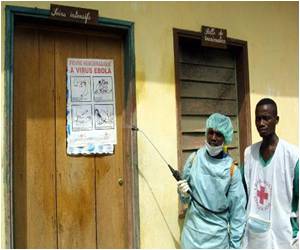A new method to study Ebola virus in wildlife has been developed, using the fecal samples from wild great apes to identify populations likely to have been exposed to the virus.

Despite 30 years of Ebola virus research, including on how it is maintained in the wild and how it emerges in wildlife, there is still much to understand. This is due, in part, to the difficulty of capturing and sampling wild animals in Africa's vast rainforests. Previous Ebola investigations have relied on blood or tissue samples collected from wildlife, but these samples are difficult and expensive to obtain. The methodology published today provides a potential solution; a simple, non-invasive tool for screening large populations of great apes for Ebola virus exposure, providing scientists and conservationists with more information about this mysterious pathogen.
"Ethical issues, as well as the cost and risk involved, make hands-on examination of wild great apes for research problematic," said WCS field veterinarian Dr. Kenneth Cameron. "This new methodology will make immunologic studies in wild apes safer and much easier, providing us with the ability to answer research questions that simply were beyond reach before."
The new methodology exploits the fact that, like humans, apes surviving viral infections develop antibodies against them. Typically, those antibodies are measured in the blood. The scientists, however, developed a laboratory technique that can isolate antibodies from ape feces.
As part of the study, fecal samples from 80 free-ranging wild gorillas from five different habitats in northern Republic of Congo were collected and tested. Almost half of those were collected within 2-4 years of confirmed Ebola outbreaks in resident apes. Overall, 10% of the samples tested positive, illustrating the success of this test in detecting antibodies against Ebola virus in feces.
Currently, the worst ever human Ebola virus disease (EVD) epidemic is occurring in West Africa. The virus responsible, Zaire ebolavirus, has been associated with human outbreaks and major declines in wild chimpanzee and gorilla populations in Central Africa. Human cases have tended to follow wildlife outbreaks, usually through the consumption of infected wildlife, including great apes and fruit bats.
Advertisement
WCS veterinarian Alain Ondzie said, "If scientists can better understand patterns of Ebola virus infection in wildlife, the public health sector can be more prepared to prevent human outbreaks."
Advertisement
"It is fantastic that we can get this type of information from simply collecting fecal samples from the forest floor," said Dr. Patricia Reed, who helped oversee this work as a wildlife veterinarian for the Wildlife Conservation Society (WCS). "From a wildlife conservation perspective, we can use this information to target our limited resources and get more information in-hand more quickly in order to protect great ape populations most at risk for new infections. And the more we learn about the ecology of this pathogen, the more we can proactively assist the public health community."
With this method, ape feces can be collected over large areas of forest habitat where Ebola is a threat, and levels of antibodies in the sampled animals can be compared over time and between seasons and regions – all without the expense and risks of animal capture and handling. Fecal screening thus opens many new exciting doors to better understand the disease ecology of Ebola and potential management options. For wild great apes this includes longitudinal studies of immune response that can be paired with genetic identification of individuals following outbreaks, identifying unexposed populations for greater anti-poaching protection or future vaccine studies, and monitoring the effectiveness of Ebola vaccines, should such vaccines become a practical reality for free-ranging great apes. This approach could also be adapted to other species that may play roles in Ebola virus transmission, such as small antelope and wild pigs.
Source-Eurekalert










